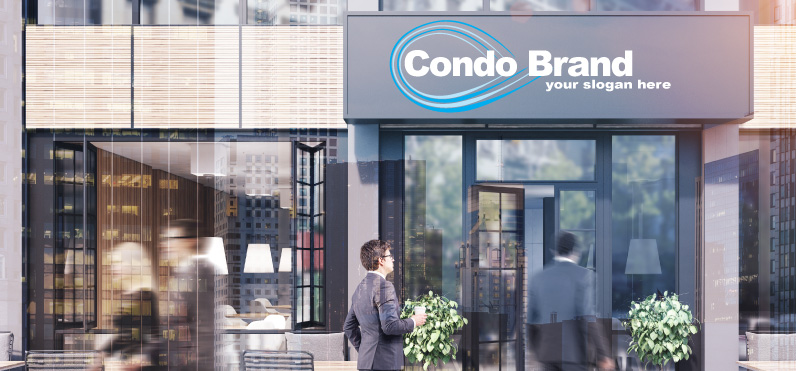Apr 28,2021
Condominium boards and managers play an important role in preserving and increasing property values. Most often, we think about this in terms of providing responsible building, facilities, and asset management. Not to be overlooked is managing the brand and good name of the association in order to protect, enhance and distinguish its status and reputation and to prevent damage by disgruntled community members or competitors.
An association’s identity is an asset. Associations can and should develop a brand that builds a positive reputation.
An association’s identity is an asset. Associations can and should develop a brand that builds a positive reputation. Everyone understands the importance of branding when it comes to promoting everyday consumer products like beverages and clothing, and it is also important to think about how an association’s or building’s brand is cultivated and protected. In a competitive market, branding can separate the product and allow the consumer to identify quality and value. The Boston luxury market can be extremely competitive. Buyers have an expectation of quality and value, and all unit owners benefit when the reputation for quality and value are upheld. Even in a seller’s market, to preserve and enhance value, a community must have a positive reputation and good will. Brand confusion, dilution or outright usurpation can have as much of a detrimental effect on unit values as it would for any consumer product. Associations can take charge of their community’s narrative, image and identity, not only to prevent damage, but to affirmatively enhance its image in the community. It can be an opportunity to highlight the history of the community, neighborhood benefits, lifestyle, and details that make the community stand out.
Protecting Your Good Name & Trademarks
A disgruntled unit owner or neighboring property owner can create and use an email account, webpage, social media account, newsletter or other communication tool using the association name or logo and distribute false, misleading or confusing information about the community that can negatively impact the reputation of the community and interfere with its management. For the association members, it can also create confusion as to whether the communication is official and the content accurate or reliable. Just as consumer products take advantage of trademark and copyright protections, so too can associations. Associations can evaluate whether to register a tradename (the association name) or a trademark (the association logo) to prevent others from using its name and associated marks/symbols. First, the association will want to evaluate if the name and logo are likely registerable – names that are a geographical descriptor or not sufficiently descriptive may not be registerable. If an association has a registerable name or logo, it can apply with the United States Patent and Trademark Office (“USPTO”). The process of applying and registering a trademark can take a few months. Once the application is submitted, the USPTO will review it to see if there are any conflicts and if it meets the technical requirements for registration. After initial review, the application will then undergo a publication period to determine if there is any opposition/objection, after which the USPTO conducts a final review for ultimate determination of approval. Once trademarked, the owner has exclusive right to use that name or mark and to protect against unlawful use. Trademarking the association name and any logo is a more conservative approach, but can offer greater protection from unlawful imitation and is a relatively simple process. If you have not trademarked your name or logo, but someone is making improper use of it, there are still common law rights upon which you can rely, but these are more limited. Associations should contact counsel if they have questions about how best to protect their name, logo, or other elements of their brand.
Practical Tips for Protecting the Association’s Brand
In addition to trademarking the association’s name and logo, some other practical tips to consider to protect your association’s name and image:
• Register a web address with your association’s name, purchase related domain names and let owners know the “official” address.
• Secure related social media account names (i.e. Facebook page and Twitter and Instagram accounts).
• Secure e-mail accounts using the addresses likely to create confusion as to which is the “official” account.
• Create a web presence that highlights the positive identity and brand of your association.
• Make consistent use of a logo that appears on association signs, newsletters, website, social media, handbooks, letterhead, and at community-sponsored events -- this will signal to association residents that a communication or event is official.
• Conduct web searches on a regular basis to identify unauthorized uses of the association name or imitation sites/communications that may cause confusion.
• Consult an attorney about sending a cease and desist or warning letter if someone is misusing the association name or logo, even if you do not have a trademark. There are certain common law protections and you have an important business interest in protecting the name and goodwill of your association and preventing confusion and negative influence.
Words of Caution on Websites and Social Media
Websites and social media can be great tools for communicating with owners and a part of the effort to brand an association to the community at large. There are, however, important considerations for running websites and social media that should be addressed before launching and administering them. It is important that you will be able to keep content updated and current. Stale content and an incomplete buildout can project a negative image about the management of the association.
It is also important to keep separate what is primarily showcasing content for the public from content that is for association business and intended for residents only. If a portion of the website is for resident business only, it should be restricted. Associations can develop public-facing web content and another part of the website that is accessible by owners with a password.
In addition to separating website function, it is also very important to have a policy concerning content of the website and on social media. We recommend associations adopt a clear, written website and social media policy that prohibits inappropriate content, identifies who will be responsible to manage and monitor the web presence, and reserves the right to remove offending content. In general, the goal of the website and social media is to distribute information about the community and the community offerings such as meetings, notices, announcements, updates, and event information. This is not a space to distribute and post confidential and personal information; political opinion; abusive, threatening, obscene, discriminatory, offensive or defamatory statements; advertisements/third party solicitations; photographs of children without parent/guardian consent; and copyrighted materials/images.
The goal is for the website and social media to engage residents and potential residents in a positive manner. It should build up the community, but as with all things online, there are risks if not properly managed and proper protocols put in place. This may also speak to the selection of what platforms to use to communicate. Different social media platforms have different security policies, policies on posting, and ability to remove posts. Associations should review what platforms are appropriate for them. Finally, associations should be clear about who is responsible for the management and administration of the association’s website and/or social media.


